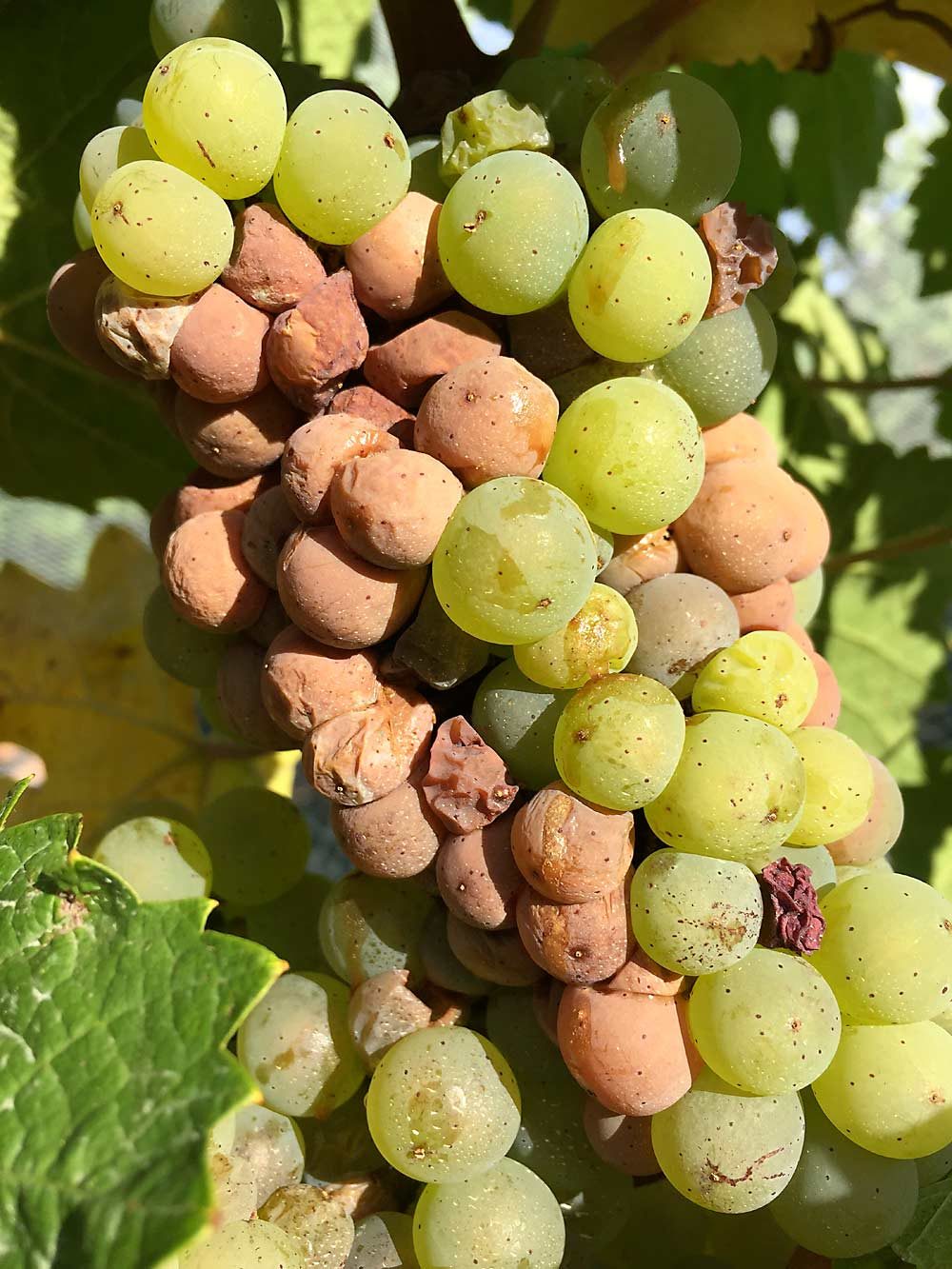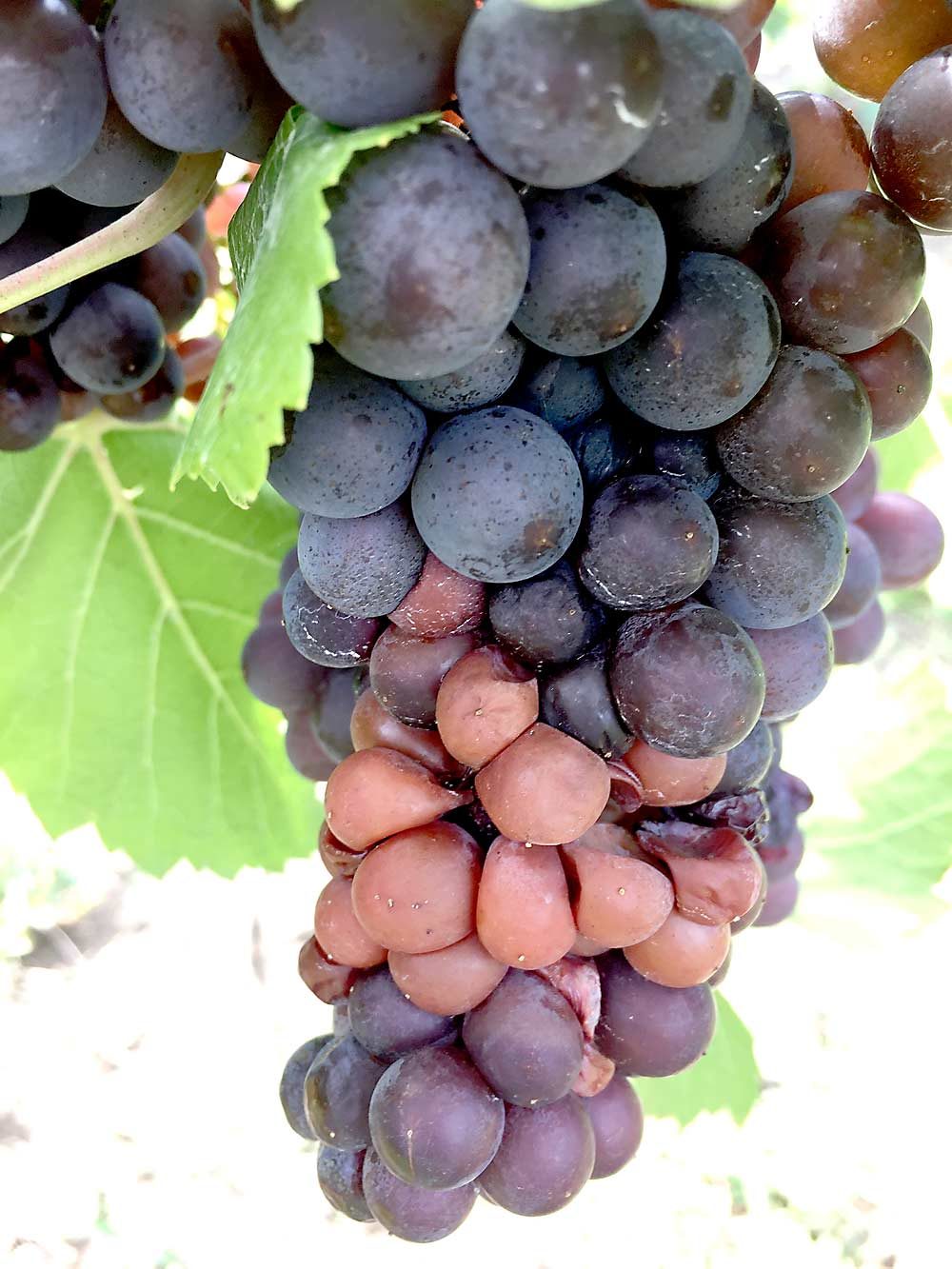
Sour rot can turn a promising crop of sweet, plump, luscious grapes into soft, browning, vinegary berries right before harvest. Prevalent in cooler climate wine growing regions of the world, this poorly understood disease is now getting more attention from researchers, including University of Missouri professor Megan Hall.
“Back when I started studying sour rot, we honestly knew very little about it,” she said, referring to work she started in 2013 while a graduate student at Cornell University. “We didn’t know what caused it, how it progressed, or how to manage it, so anything we did at that point was going to be a major advancement in our knowledge.”
Sour rot is often confused with botrytis bunch rot, but the distinction is important because the fungicides that target bunch rot won’t work against the bacteria and yeast driving sour rot, according to Wendy McFadden-Smith, grape integrated pest management specialist at the Ontario Ministry of Agriculture, Food and Rural Affairs.
Hall’s most recent findings sort out the role of two other key factors in the sour rot complex: wounds and fruit flies. That understanding gives growers options for controlling it.

“This is a multitrophic disease that requires a wounded grape; a yeast to ferment the sugars in the grape juice and generate ethanol; acetic acid bacteria to convert that ethanol into acetic acid, which is the ‘sour’ in sour rot; and fruit flies,” she said.
The yeast and bacteria naturally occur on and in grapes — healthy or otherwise — but only those grapes with a wound can actually develop sour rot.
For instance, Vignoles is widely planted in viticulture across colder climates in the United States, and it’s renowned for its extremely tight clusters, Hall said.
“Well, those tight clusters tend to lead to wounds, because they rub up against one another as the berries expand, and as it turns out, Vignoles is one of the most widely affected by sour rot,” Hall said.
Then again, she noted, she has seen sour rot occur in cultivars that aren’t tightly clustered or thin-skinned, so in any variety, “anywhere a wound can form, there’s a potential for this disease.”
Even wounded grapes, however, aren’t enough for sour rot to arise. Fruit flies must also be present, she said, but it’s still unclear exactly what role they play in the development of sour rot.
For that question, doctoral student Patrick Kenney has now joined Hall’s group to identify the fruit fly’s role in the disease. A focus of his research will be the possibility that the flies are excreting an enzyme or other compound that triggers sour rot and at what stage of development the flies pose the most risk.
“It would appear that other stages of the fruit flies are able to cause symptoms at the same rate as the adults,” Hall said. “Patrick has a really strong integrated pest management background, so he is not only trying to understand what exactly the fruit flies are contributing to the matrix, but also trying to develop more specific management strategies, such as targeting different life stages, so that we can better manage this disease.”

Grower recommendations
As the research progresses with funding from the Missouri Wine and Grape Board Research Committee and the University of Missouri, Hall is advocating that growers watch for signs of sour rot and spray as necessary to reduce the disease in their grapes.
“I highly recommend to growers that they go out into their vineyards a couple of weeks before harvest when they’re passing that 12 to 13 Brix level, because that’s when sour rot normally hits,” Hall said. “If a grower starts to see fruit flies buzzing about, that is a good time to get a first spray on.”
She advises using an antimicrobial plus an insecticide.
After that, growers should monitor the vineyard, and if they continue to see fruit fly activity plus sour rot symptoms on certain blocks or varieties, they should selectively repeat the combination spray — alternating insecticides to avoid resistance — on those areas, Hall said.
“This is not something that has to be done across all of the grapes in your entire vineyard, because you may get very bad sour rot in one of your varieties or one of your blocks, but not in the rest,” she said. “It’s really about keeping a close eye and applying an insecticide and antimicrobial when they’re needed.”
Hall’s recommendations align with those from Ontario researchers. In terms of cultural control, McFadden-Smith also recommends leaf removal — stripping six basal leaves for each fruiting shoot — based on Ontario vineyard trials. Applying calcium or silicic acid to reduce fruit cracking at regular intervals after berries reach pea size can protect fruit as well, she told Good Fruit Grower in 2018.
Now, Hall’s group is working with commercial growers to test the efficacy of different spray frequencies, and she hopes to fine-tune recommendations in the coming year as a way to bridge the gap between research and application. •
—by Leslie Mertz
Related:
—Studying the rot of the problem






Hi
Id like new updates on sour rot control.
I have alot of tight clustered varieties and have sour rot issues, almost every year.
Thank you
Dan
An unknown disease appears in mid-July when the berry has gained size and should sing, and the closer to ripening, the more berries rot when you crush the berry, soft liquid, light pink in color and smells of Wine. The place where the rotting of the berry began has either a hole or a slot like a Coffee seed and some kind of incomprehensible cobweb near the hole / slot. Sprayed 1) in the spring with urea with copper sulfate, alternated with chorus and fundazole and Bordeaux mixture. 2) the beginning of summer Chorus, fundazole, once with a Bordeaux mixture.3) when I noticed rotting, I sprayed Fundazol, chorus, copper sulfate, medea and all the berries are rotting exactly. What is this disease?, the average temperature at night is +28*C- +35*C during the day to +49*C. It is when the heat is standing that they begin to rot. Please help. I live in Kazakhstan , region Mangystau, town Aktau.